Creating Sales Orders
Transactions > Sales Orders
Create customer Sales Orders from the Transactions menu or directly from the Debtor Account > Orders tab.
-
Click the New button to create a new Sales Order, or click the arrow to the right of the button to create a new quote, layby or standing order. The type of Sales Order is indicated in the title bar near the top of the window.

-
A Quotation is a Sales Order that doesn't commit any stock until it is converted to an invoice or standard Sales Order. No GL transaction is created until it is converted.
-
A Standing Order is a Sales Order which is not actioned until you process it in the Process Standing Orders window, at which point each standing order is converted to an invoice. It is used when the debtor wants exactly the same Sales Order to be supplied, often at regular intervals. No GL transaction is created until it is converted.
-
A Layby Sales Order does commit the stock item quantity. Normally deposits are made on laybys, and you can specify a default deposit percentage, and enforce it.
-
-
The Sales Order window opens:
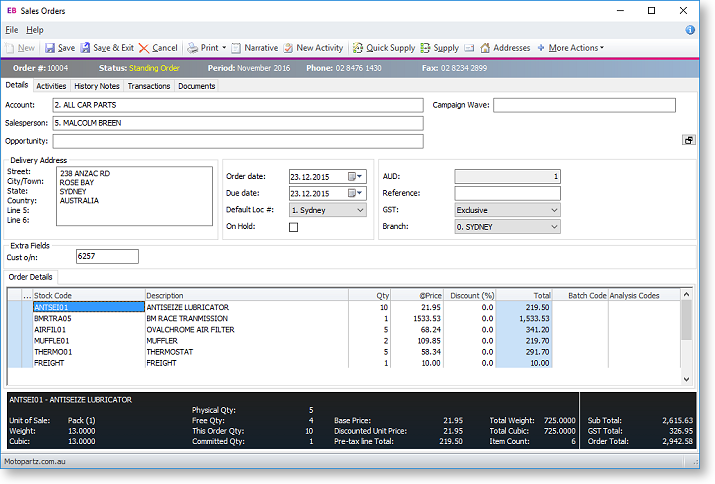
Enter the Sales Order details using the following table.
Field
Description
Account
The account for which you are creating the Sales Order. You cannot process a Sales Order for an account on stop credit; a warning will be displayed.
Contact
If the Add debtor contact details to transactions profile setting is enabled, a Contact can be selected for the Sales Order. Correspondence related to the order will be sent to this Contact's email address, rather than the account's email address.
Salesperson
Enter the salesperson you want to record as having made the sale. To search for a salesperson, type '?' in the field and tab.
Campaign Wave
If the Exo Business CRM module is installed, Sales Orders can be associated with a campaign wave to track sales against a marketing campaign.
Opportunity
This field is available if the Exo Business CRM module is installed. If the Sales Order was generated from an Opportunity, the Opportunity will be entered here automatically; otherwise, one can be manually entered (enter ? and press tab to search for an Opportunity).
Delivery Address
The default address of the debtor account. Click the Home icon in the toolbar to select or create another delivery address for the account.
Order Date
The date the Sales Order is created.
Due Date
The expected time of arrival to the customer of the Sales Order.
Default Loc#
Choose the stock location from which you are supplying the stock. You can specify location at the Sales Order line level by clicking on the Sales Order Line Periscope button and selecting the required location in the Location field.
On Hold
Putting a Sales Order On Hold changes the Sales Order status to Not Processed. The quantity of the ordered stock item is still committed. The status bar at the top of the Sales Order has a red background.
In the Sales Order search window, you can filter on Sales Orders which are On Hold.
AUD/NZD
The currency of the transaction.
Reference
Any reference annotation you require on the Sales Order.
GST
Select whether the prices shown on the Sales Order are GST-inclusive or -exclusive. Changing this setting affects the Sub Total, GST Total and Order Total values at the bottom of the window.
Consign loc
This field is displayed if the Allow Consignment stock orders through Sales Orders profile setting has been enabled in Exo Business Config. To create a consignment order, make sure you select the Consignment location here. This is the location from which the stock is supplied.
Branch
The branch of the Sales Order. If the profile setting Allow Sales Order search, view & creation for other branches is enabled, you can specify any branch in this field.
Extra Fields
Cust o/n
Any Extra Fields created for the Sales Order header are displayed in this section.
Note: Extra Fields on the Sales Order header can be configured to update their values whenever the Debtor account number on the Sales Order is changed; similarly, Extra Fields on Sales Order lines can be configure to update whenever the Stock code on the line changes.
If you have an Extra Field for the Customer Order Number set up, the profile setting Validate debtor order numbers in is set to "On Entry" or "On Save", and the Debtor for which you are creating the Sales Order has the Need Ord No checkbox ticked in the Debtor Account Details window, then entering an order number for the Sales Order is compulsory. A check is also made to ensure the order number hasn't already been used.
-
Enter the stock item details for the Sales Order in the grid below, using the following table.
Field
Description
...
Click in this column to open the Sales Order Line Periscope for the current line.
Stock Code
Enter the stock item code, or type '?' and tab to select from a list. To add a Bill of Material in Sales Order entry window, enter a full stop (.) then the Bill code on the Sales Order line stock code column.
Description
The description of the stock item.
Qty
Enter the quantity of the stock item being ordered.
@Price
The price of the stock item.
Note: You can click the
 button to check the prices of all lines against the latest
cost and selling prices from the Stock ledger.
button to check the prices of all lines against the latest
cost and selling prices from the Stock ledger.Discount (%)
Enter any discount for the line. This column will not appear if you disabled the profile setting Allow manual entry/override of discounts on debtor invoice and sales order lines in Exo Business Config; this also applies to the Discount field in the Sales Order Line Periscope.
Total
The total for the line.
Analysis Codes
Enter the analysis code you want to use for this Sales Order line.
Note: Sales Orders are limited to a maximum of 1000 lines.
-
To add a description of the Sales Order, click the Narrative button.
-
To add a one-off stock item, right-click in the grid and choose Create One-Off Stock Item.
-
Once you have entered information in the header part of the Sales Order, you can minimise the Sales Order header by clicking on the Minimise/maximise button in the top right corner of the window. You can also view the Sales Order line total excluding tax and the discounted unit price excluding tax of a Sales Order line in the bottom panel of the window.
-
Click Save to save the Sales Order. The system will assign the next number, and prompt to print the Sales Order.
-
To make deposits against Sales Orders, the profile setting Allow deposits in sales orders and general ledger in the Configuration Assistant needs to be enabled. If enabled, when you save the Sales Order, you are asked if you want to make a deposit against the Sales Order. You can also specify the percentage required for a minimum deposit on any Sales Order, using the Minimum Layby Deposit Percentage profile setting.

-
Click Yes, and the Payment/Receipt window is displayed in which you can enter the payment details.
-
If you use dispatch methods, and the profile setting Prompt for dispatch information for debtor invoices and sales orders is enabled, you will be prompted to select the dispatch method from the list displayed.
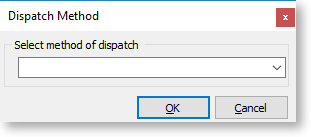
The following table describes the toolbar functions at the top of the window:
|
Button |
Description |
|
Narrative |
Add a narrative to the Sales Order. |
|
All Lines/Outstanding |
For partly processed Sales Orders, this button filters the Sales Order lines to view all, or view only outstanding, i.e. not processed, lines. |
|
Quick Supply |
Quick Supply all Sales Order lines in the Sales Order. |
|
Supply |
Supply, or part-supply, the order. |
|
|
Emails a copy of the Sales Order to the email address recorded for the Debtor account on the order. |
|
Addresses |
Add extra delivery addresses to the Sales Order. |
|
More Actions |
|
|
Tax Summary |
Display a summary of all tax rates that apply to the items on the Sales Order. |
|
Account |
View the Debtor Account Details window for the debtor account of the Sales Order. |
|
Check Prices |
Check the prices on the Sales Order against the latest cost and selling prices from the Stock ledger. |
|
History |
|
|
Generate PO(s) |
Generate one or more Purchase Orders based on the Sales Order. |
|
Review Stock Availability |
This options is available for unprocessed Sales Orders when back orders are enabled. It opens a new window where stock levels for the items on the Sales Order are displayed. |
Adding a Bill of Materials to a Sales Order
You can select Bills of Materials (BOMs) by entering a "." (full stop) in the Stock Code column and pressing ENTER. This opens a list of active BOMs for you to select from. After selecting a BOM, you are prompted for the quantity that you require:
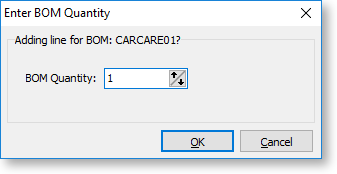
Note: Decimal quantities can be entered if the Quantities value at Exo Business Config > Essential > General Settings > Decimal Places in Numeric Values is set to a value greater than zero.
When inserting a BOM, the system will draw in its default components. A BOM header displays in bold. Its cost and sell price is calculated from the sum of its component lines, which have a shaded background. Any change to these component lines will result in a change rolling up to the BOM header. The totals are calculated on the sum of the component lines of BOMs together with normal non-component lines.
If the BOM is priced by total, then after inserting the BOM lines you will be asked to confirm the total price for the BOM:
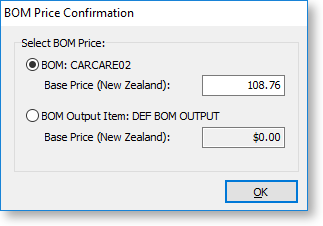
The top option obtains its price from the Bill of Materials setup screen. This price is editable at run time and is apportioned across the kit lines (price rollup/rolldown). If the BOM has an output code pointing at a stock item code, the system will test for the best price on that stock code and the result will be offered with the bottom option. This price is not editable but may be selected if desired.
Copying Sales Orders
You can also create a new Sales Order by copying an existing order. To copy a Sales Order:
-
Select the order and click the Copy Order button (
 ).
Alternatively, right-click on the order and select Copy
Order. The following window opens:
).
Alternatively, right-click on the order and select Copy
Order. The following window opens: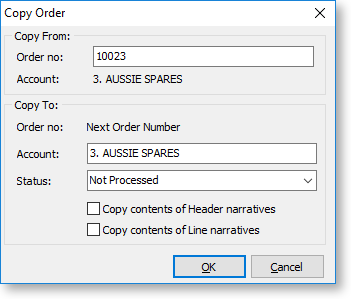
Note: You can specify a different order to copy by entering a different number into the Order no field.
-
Enter the Debtor account to raise the new order for. This defaults to the account of the order being copied.
-
Select a Status for the new order.
-
Select whether to copy header and/or line narratives to the new order.
-
Click OK. The new Sales Order opens.
-
Save the order and close.
Reviewing Stock Availability
Where back orders are enabled, the More Actions > Review Stock Availability option is available for unprocessed Sales Orders. Selecting this option checks for stock shortages on the Sales Order - if any are detected, the Stock Availability window opens, displaying stock levels for the items on the Sales Order:
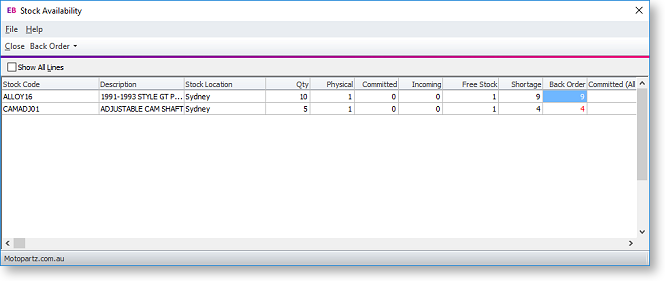
Note: For this window to appear, the Check available stock for sales orders profile setting must be enabled, and the Default response to backorder prompt profile setting must be set to “Yes” or “No” (not “Never”).
By default, only line items that have stock shortages are displayed - tick the Show all lines box to display the details of all lines on the Sales Order.
The Back Order quantities for each stock item can be edited on this window. The Back Order dropdown contains additional options for backordering stock items:
- Backorder shortage quantities
- Force backorder entire quantities for shortage lines
- Force backorder entire quantities for all lines
- Reset backorder quantities to zero
Note: If the Default response to backorder prompt profile setting is set to “Yes”, the Back Order quantities will be set to the Shortage quantities by default.
Additional Tabs
Once a new Sales Order is saved, additional tabs become available on the Sales Order window:
